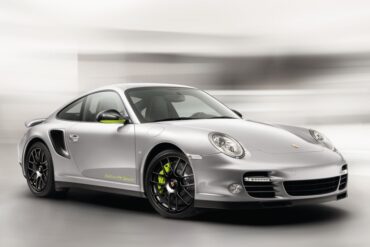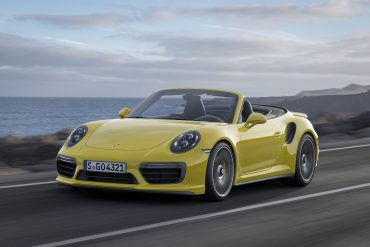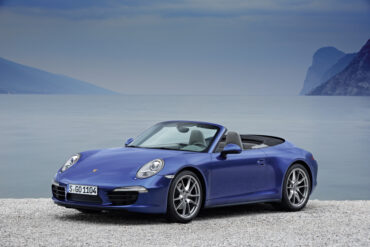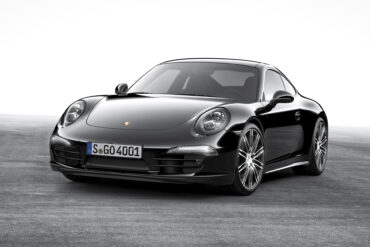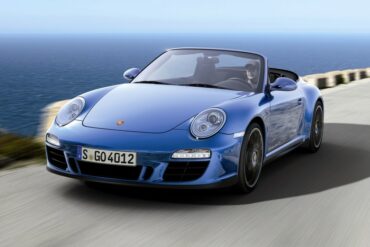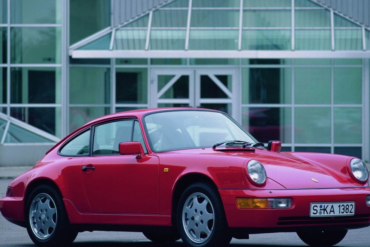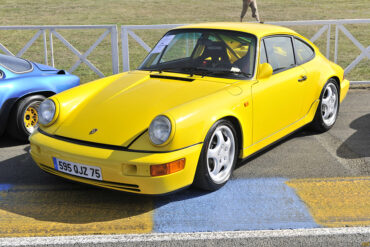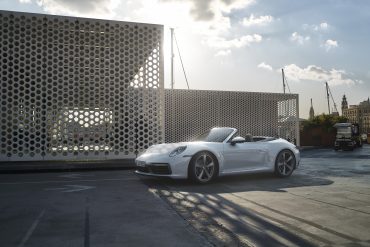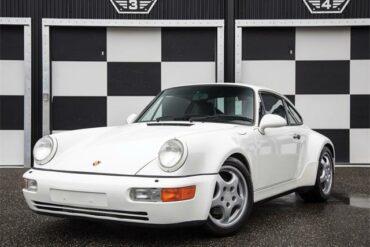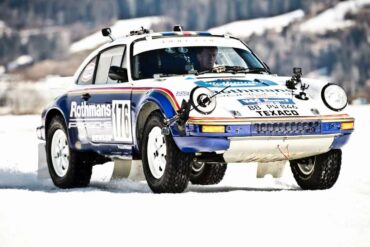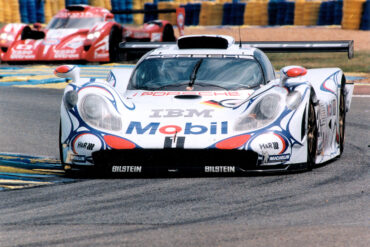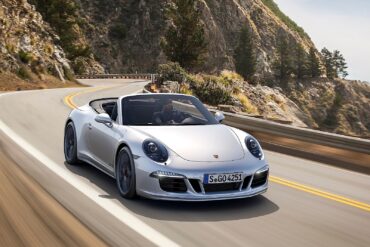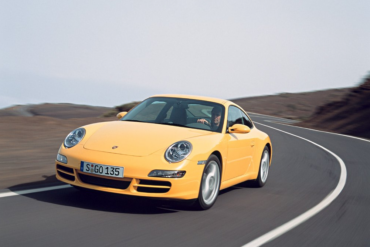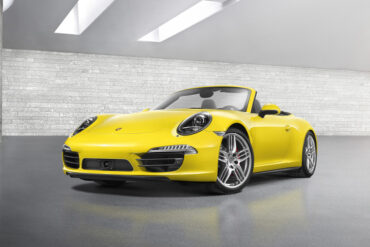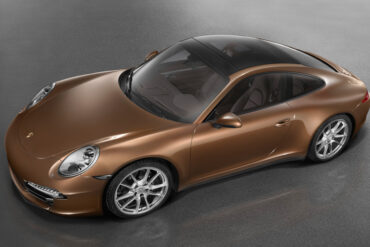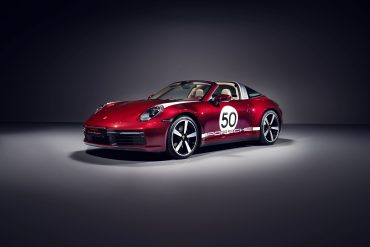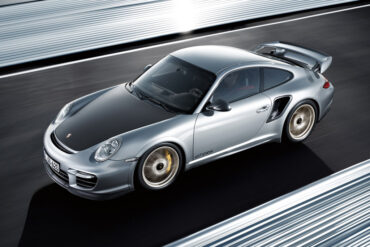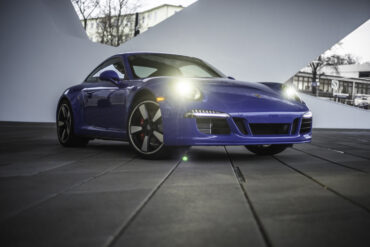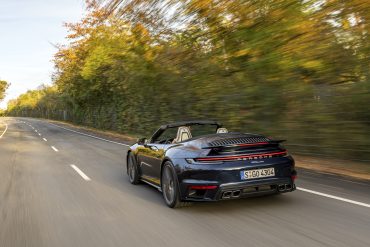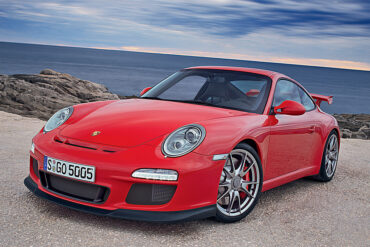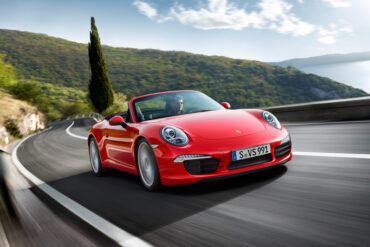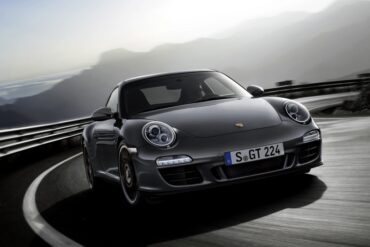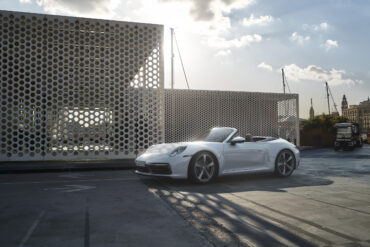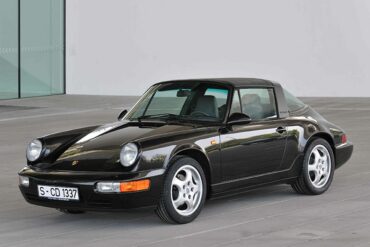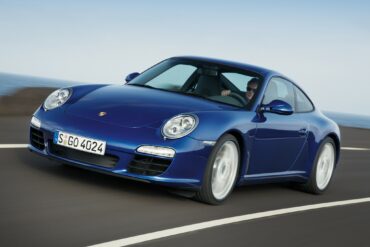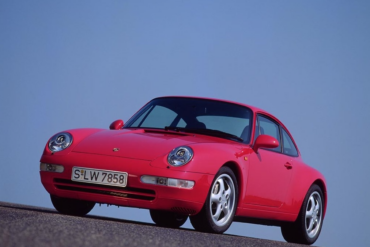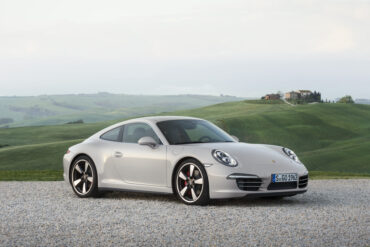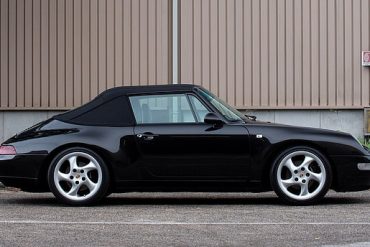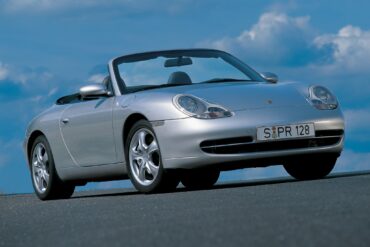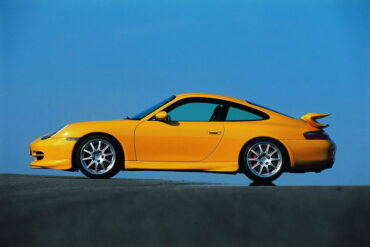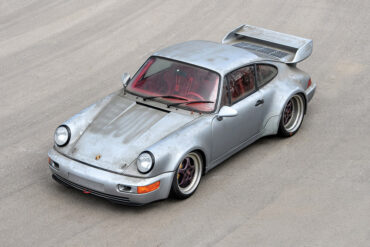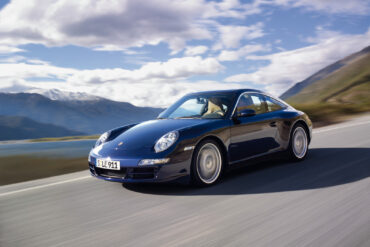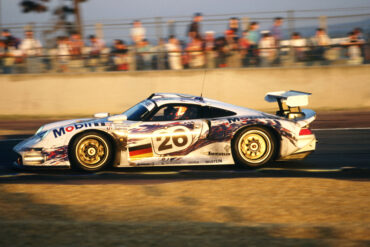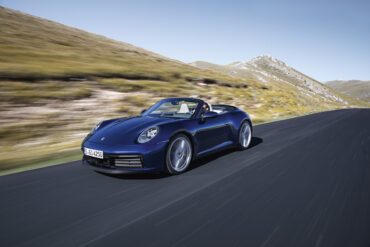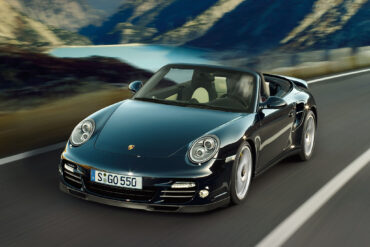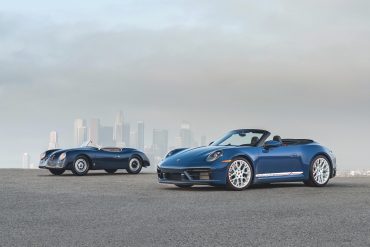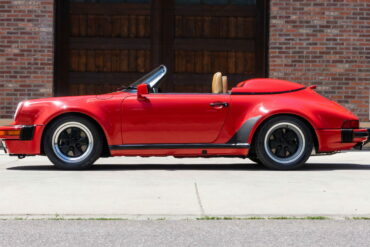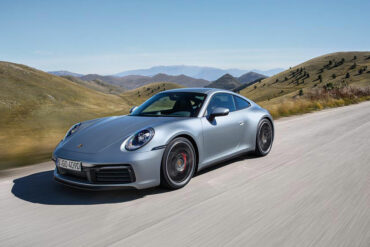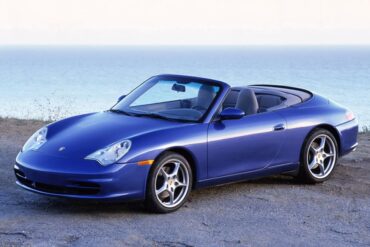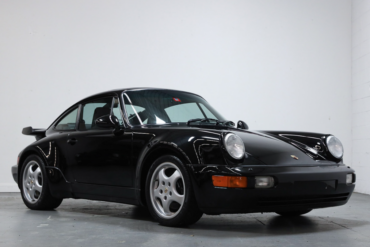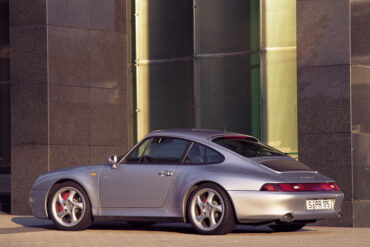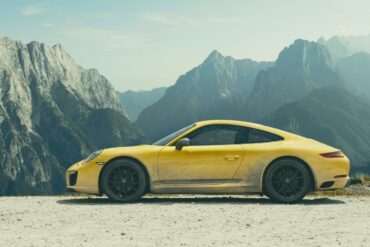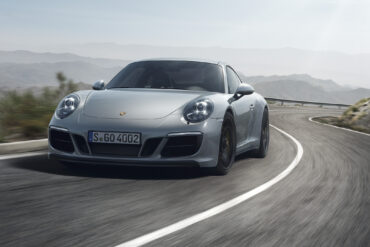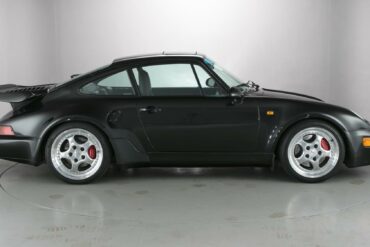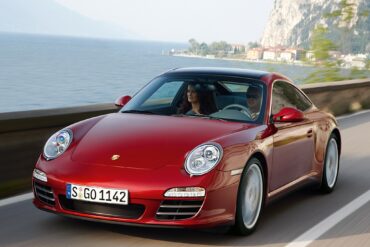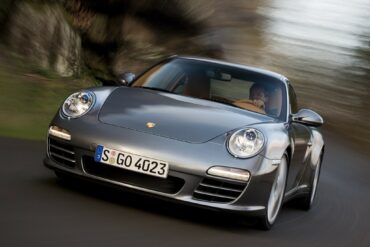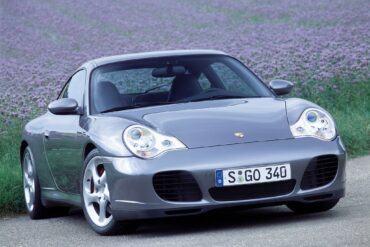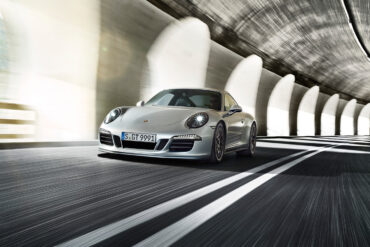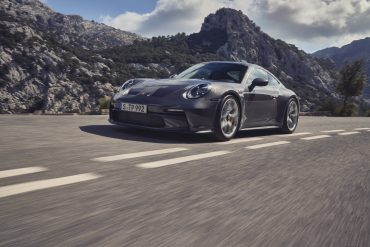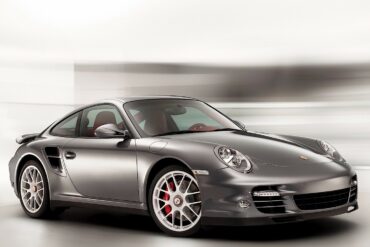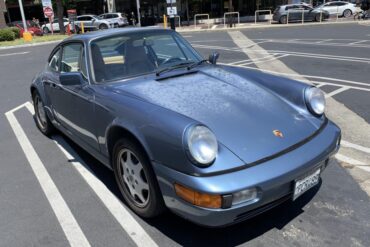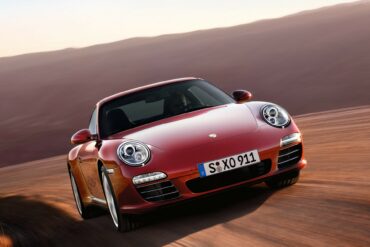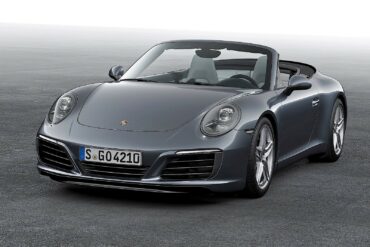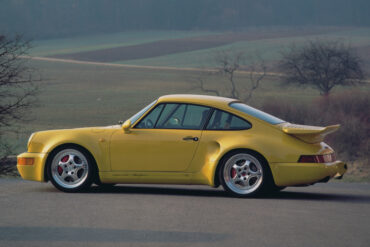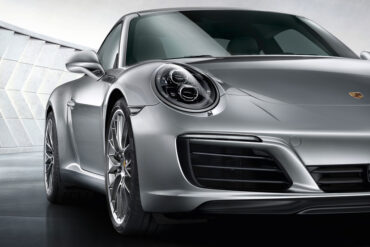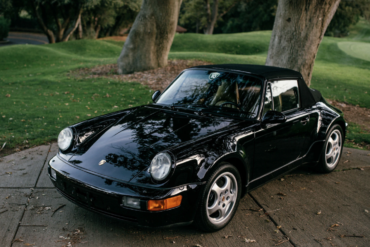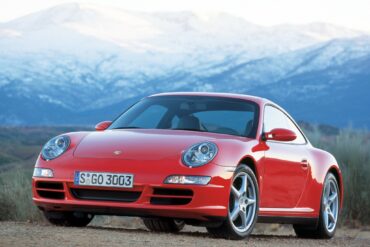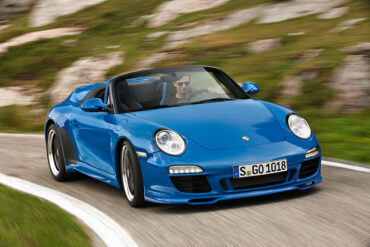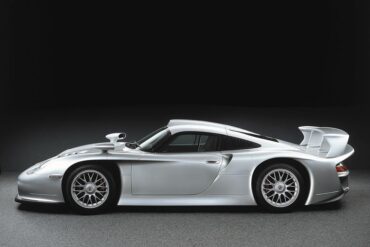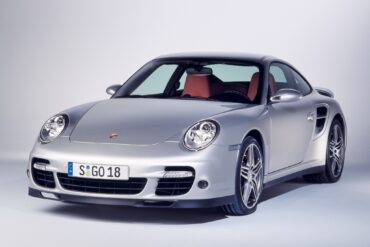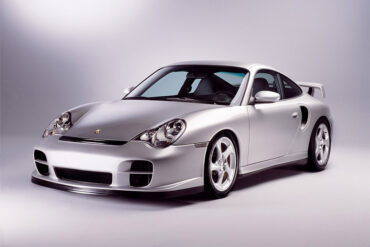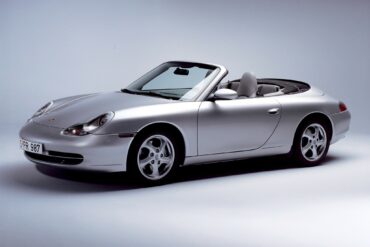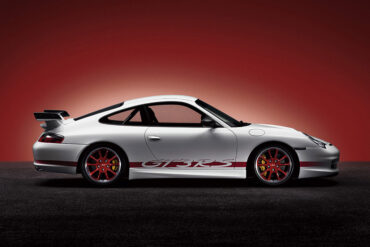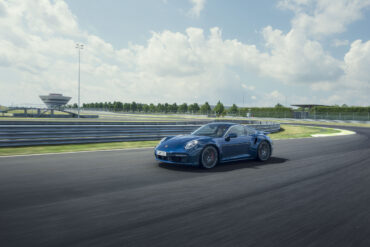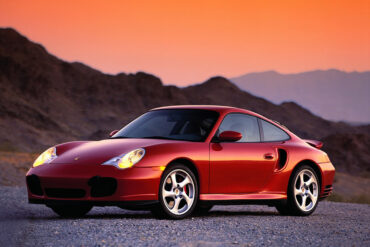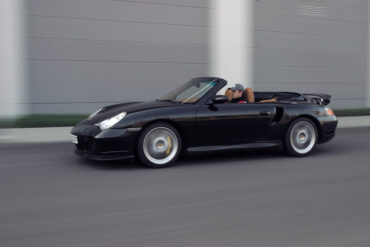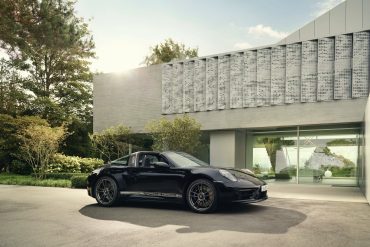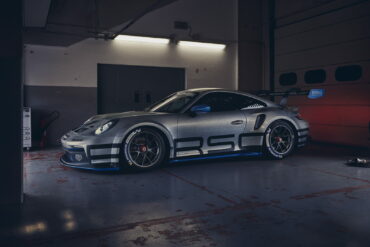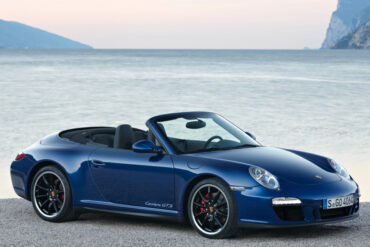Based on the 530-bhp 911 Turbo S, the special-edition Porsche has carbon-fiber trim inside and out, plus upgraded leather, badging and the exterior colors of the 918, including the use of Acid Green on the brake calipers, illuminated sill plates, interior stitching and instrument cluster needles. Also limited to 918 units, the 911 Turbo S Edition 918 Spyder will be available in Coupe ($160,700) and Cabriolet ($172,100) forms, making this one very expensive dealer option.
This is the fastest convertible GT you can buy. The Turbo S cab gets 572 bhp (39 hp more than the base turbo cab) and 553 ft lbs (9 ft lbs more than the regular cab) of torque. With the Turbo S, the PDCC Porsche Dynamic Chassis Control hydraulic roll bars came as standard. The PCCB Porsche Ceramic Composite Brakes had been standard on the Turbo S already since the 996 generation. New options included the radar-based lane change assist and a lift system for the front axle (increased ground clearance by 1.6″/40 mm). The PCM now had a multi-touch screen like in the facelifted 991 Carrera.
The new Porsche 911 Carrera 4 unites the excellent performance and efficiency of the new generation of the 911 Carrera with the dynamic benefits of the latest version of the active all-wheel drive system PTM (Porsche Traction Management). The typical Porsche all-wheel drive with rear-focused layout in this latest 911 version guarantees maximum vehicle dynamics on a wide variety of road surfaces and in all weather conditions. The new 911 Carrera 4 models deliver traction and dynamic performance the power of four.
Just a few months after the introduction of the 2004 911 (997 series), the convertible version was released. The release of the 997 911 Carrera Cabriolet marked the first time since 1977 that Porsche has given the convertible 911s the same engines as their Coupe siblings. The base 997 Carrera Cabriolet gets the 3.6-liter flat six-cylinder engine with 321 bhp and 273 ft lbs of torque. The convertible version for both Carrera and Carrera S was developed at the same time with the coupe.
The 2016 Carrera and Boxster Black Editions add some extra niceties for a value-adjusted price. And as the names suggest, both cars come in any color scheme you want so long as it’s, yes, black on black. Or black on black on black in the case of the ragtops. Available in coupe and convertible forms, with rear- or all-wheel drive, each powered by the base 350-hp 3.4-liter flat-6 engine, the 911 Carrera Black Edition adds other design treats too.
The Cabriolet version of the new Porsche 911 Carrera 4 GTS is just as potent as its coupe sibling. It combines a 408 hp 3.8-litre flat six engine with intelligent all-wheel drive that delivers a further exhilarating dimension to the dynamics of the iconic rear-engined sports car. The 911 was first offered with four-wheel drive in 1989 and the drivetrain has been a popular option ever since. Now, the 911 Carrera 4 GTS broadens customer choice in 2011, building on the success of the two-wheel drive Carrera GTS that went on sale in December last year. Carrera 4 GTS power unit is the 3.8-litre flat six with power kit.
Porsche added the rear wheel drive Carrera 2 variant to the range in 1990. It was developed alongside the 964 Carrera 4, Porsche waited a year to release the Carrera 2 as a 1990 model year car. Like the Carrera 4, the Carrera 2 was available as a coupé, Targa or Cabriolet. Overall, the Carrera 2 packed almost the same technical specifications as the Carrera 4 model. The engine was the same 3.6 liter unit which produced 250 horsepower and a maximum speed of 162 mph. Looked like C4 but was 200 lb lighter and more fun to drive.
The most basic version of the Porsche 911 Carrera has now been unveiled. Porsche chose to detune the twin-turbocharged flat-six engine and downgrade some of the chassis components. These cars offer very good performance and driving dynamics for a slightly lower price. While marginally larger and heavier than the 991-generation model it replaced, the 992 is also more advanced. Power climbs by 15 bhp from the 991 Carrera, to 379 bhp @ 6500 rpm, which is more than enough horsepower for the street.
For race teams and track day customers Porsche prepared a small number of the 964 Cup cars according to the FIA NG-T regulations. Officially called the Competition model, these custom-ordered cars were an intermediary step between the Carrera Cup option (M001) and the standard tourer (M002). This M0003 option was available directly from Porsche as a road-going model. These cars had almost all the Carrera Cup modifications including the new suspension. This lowered the car by 40mm in the rear and 50mm in the front. It also included fitting of the larger 930 Turbo disc brakes and adjustable anti-roll bars.
The Carrera 4 is the base model 911, equipped with all-wheel drive. It starts at $109,850 for 2022, which is about $7,000 more than the standard rear-drive Carrera. Other than the additional all-wheel-drive system and the 150 odd pound increase in curb weight, the Carrera 4 is identical to its rear-drive sibling. It gets the same 379-hp, twin-turbo 3.0-liter flat-six engine. The twin-turbocharged 3.0-liter flat-six has 379 hp.
Model year 1994. Carrera 4 Wide-Body for the U.S. Technically there is really no difference between the Carrera 4 Wide-Body and his RoW counterpart. At the front there are the for America usual black impact absorbers beside the fog lights, the frontfenders lack the side indicators, the rear bumper is equipped with the center piece with a small plate section and in the back window of a large third brake light is integrated. Significant differences, it is generally provided in the factory standard equipment.
The Porsche 953 ranks as one of the finest off-roaders Porsche has ever made. It was basically a souped-up 911 designed specially to give Porsche an advantage in the 1984 Paris–Dakar Rally. Just a year later, it was replaced by the 959. Despite its brief run, it still managed to make quite the impression. Built around a massively enhanced suspension and a supremely powerful 300 bhp (224 kW), 6-cylinder engine, it showed Porsche knew more than just sportscars.
The 1998 GT1 car was a totally rethink and vast upgrade versus the prior year car. 1998 Le Mans 24-hour race In the 1998 jubilee year, the Porsche team celebrated its 16th overall victory in Le Mans with a double win for the 911 GT1 98. On 6th/7th June, the winning car was driven by Laurent Aiello, Allan McNish and Stéphane Ortelli. It was almost 50 years to the day on which the first Porsche sports car saw the light of day.
So what else do you get when you buy a 991 Carrera 4 GTS Cabriolet? First of all you get a 30 hp bump over the Carrera 4S to 430 hp from the 3.8L naturally aspirated flat-six. You get forged centre-lock black 20-inch wheels, dynamic engine mounts, the Sports Chrono Package, PASM adaptive damping with a lowered ride height, an interior swathed in Alcantara, a sinister front fascia with black intakes and custom rear apron with black tailpipes that broadcast the goods through an uber-nasty sport exhaust system. Other trim details include black lettering and smoked headlights.
The second generation GT3 takes all that was good about it's predecessor and then improves it! Power from the GT1 derived flat-6 is up by 21 bhp to 381 bhp (with an 8200 rpm redline), ride height is lowered for increased stability and also has an upgraded braking setup, as it features a 6-piston calipers on the front. Two versions are offered, the more extreme 'Clubsport' showing it's track day colors with a full roll cage, racing seat and a 6-point harness. The 996.2 GT3 was the first GT3 marketed in the North America. The new Porsche 911 GT3 comes with all the features of half a century Porsche motorsport. It is a sports car for the purist through and through.
The base Carrera has essentially the same 3.6 L flat-6 engine that its predecessor, the Type 996 Carrera used, now good for 321 bhp @ 6800 rpm and with torque of 273 ft lbs @ 4250 rpm. The sprint from 0 to 60 mph is over in just 4.80 seconds and top speed is 177 mph. The quarter mile is over in a respectable 13.1 seconds. The 911 Carrera is now faster, more stable, more precise and forgiving, an altogether superior-make that more efficient-sports car than the 996.
The 2005 Porsche 996 Turbo S was available as both a coupe and cabriolet – it was basically a standard Turbo model with the X50 Powerkit and carbon-ceramic brakes fitted, alongside a few luxury features for the interior. Approximately 1558 Turbo S models (split between coupe and cabrio) were sold in 2005. Also included are small aluminum appointments to the interior and Turbo S badging. A great all-rounder with the extra power to surprise most. The Turbo S with manual transmission (coupé) sprints from zero to 200 km/h in 13.6 seconds. This is another 0.8 seconds faster than the 911 Turbo. Quite rare, with only a total of 600 units made.
The 2012 Carrera 4S Cabriolet had the same wider rear track when compared to the non-S version of the vehicle. It wasn't something everyone would notice, but the difference was there for a reason, and that reason was the wider tires installed. From behind, a rear red light-strip united the LED taillights. Inside the Carrera 4S Cabriolet, there were some luxury features. The leather-covered sport-bucket seats were covered in leather. Even the rear, unusable, seats were wrapped in leather. The center console was higher to give a sense of a single-seat racing roadster.
The 2013 Porsche Carrera 4 featured a 3.4-liter flat-six engine. It was mated as standard to a world's first seven-speed manual transmission. An automatic, PDK (dual-clutch) transmission was offered as an option. The Carrera 4 featured an all-wheel-drive torque distribution in the instrument cluster display. The most distinctive identifying feature of the 911 with all-wheel drive is still the wide rear section: compared to the two-wheel drive 911 Carrera models, the rear wheel housings 22 mm wider, and each of the rear tires is 10 mm wider.
In recognition of the 50th Anniversary of the Porsche Club of America (PCA), Porsche has created an exclusive 911 Carrera' S Coupe model featuring a distinctive exterior color, unique interior styling and commemorative touches, and a more powerful and higher performing engine. Limited to an exclusive production run of just 50 cars initially made available to eligible PCA members, the 911 Club Coupe was unveiled this past weekend at PCA's 50th Annual Porsche Parade in Hershey, Pa.
The 997.2 Turbo was introduced for the 2010 model year and received a new 3.8 litre engine capable of 493 horsepower, a significant evolution as compared to the 473hp in the 997.1 Turbo. The 997.2 Turbo was available in both manual and automatic transmissions, but the automatic evolved from the Tiptronic used in its predecessor, to a sportier dual-clutch PDK. Approximately 3,300 coupes were produced and 1,800 cabrios, far less than its predecessor. An epic all-around GT with more performance than you could ever need.
The perfect daily driving sports car with an all-weather, remarkably high-performance envelope. Like the rest of Carrera S models, the Carrera 4S is powered by the same 3.0-liter twin-turbo flat-six that makes 443 horsepower and 390 lb-ft of torque. It also comes standard with the same eight-speed twin-clutch automatic transmission with the same gear ratios, except the 4S with an added clutch and differential up front.
The GT2 RS's reputation as the most powerful street-legal car is as monstrous as this comprehensive guide. Suffice to say, this supercar has been built with the best Porsche has to offer. It's not bragging, it's just facts. There is no doubt that the new GT2 RS is the pinnacle of the 911 in terms of performance. It is simply the fastest 911 in history, and that’s a fact. It is the quickest production car to lap the Nürburgring Nordschleife. It is the most powerful 911 ever made.
To commemorate the 40th year of 911 production, Porsche built 1963 of the 40th Anniversary Porsche 911 Carrera for model year 2004. Painted only in a GT Silver Metallic finish, with a dark gray leather interior, the 40th Anniversary (or 40 Jahre in German) took the Base Model 996 Carrera and added the front fascia of the 996 Turbo, side skirts and luxury features for the cabin – including a luggage set that matched the special grey leather interior. Mechanically, the X51 Powerkit increases power to 341hp, combined with rear wheels power wheels, a standard 6-speed manual and sport suspension and limited-slip differential included.
The Porsche 911 Targa 4S Heritage Design Edition showcases what is possible with Porsche's Exclusive Manufaktur program and what to expect from Porsche's Heritage Design Strategy. Inspired by the 356 and previous generations of the 911, Porsche's Heritage Design Strategy is bringing period-correct design cues into the current 992 generation 911. Cherry Metallic is the stunning color. Limited to just 992 units globally.
Porsche’s 911 GT2 RS is a brute, a lightweight, twin-turbocharged, 620-hp bout of madness that stemmed from Stuttgart’s quest to see how high up the sports-car ladder the 911 could punch. It is the most serious roadgoing Porsche ever. The engine is a port-injected, 3.6-liter flat-six from the Le Mans–winning GT1 race car of the late ’90s, with a pair of variable-geometry turbochargers huffing a maximum of 23.2 psi of boost into the combustion chambers. The result is 620 hp at 6500 rpm and 516 lb-ft of torque at 2250. It gets a six-speed manual gearbox and rear-drive only. Yikes.
In 2002, the standard Carrera models underwent a facelift. In addition, engine capacity was also increased to 3.6-litres across the range, with power up slightly on the naturally aspirated models. 2002 also marked the start of the production of the 996 based Targa model, with a sliding glass "green house" roof system as introduced on its predecessor. It also features a rear glass hatch which gave the driver access to the storage compartment. The 996 Targa is the rarest bodystyle in the series – only 5,152 were produced (all Mk.2 generation) between 2002 and 2005.
To celebrate 60 years of Porsche Club of America, PCNA (Porsche Cars North America) ordered 60 units of 911 Carrera GTS Coupés in Club Blue from Porsche Exclusive. All 60 cars were equipped with SportDesign aerokit (including ducktail). These Club cars were not numbered because it wasn't a special series by Porsche AG, but a series of similarly equipped cars ordered by PCNA. The cars got a few unique touches by Porsche Exclusive, like the special "Club Blau" paint, the "Club Coupe" stickers on the doors, the door entry guards with ''GTS Club Coupe" lettering and number "60" embossed on the armrest cover.
All Porsche 911s are turbocharged these days but the Turbo model is something special. It gets the twin-turbo 3.7-liter flat six with tons of power and a huge $33,000 savings over the Turbo S. Thanks to an output of 573 hp, marking an increase of 32 hp over the predecessor, the new 911 Turbo Cabriolet accelerates from 0 to 60 mph in 2.8 seconds (0.2 seconds faster than before). The Turbo Cabriolet basically handles like a coupe.
In 2011, Porsche China released a special limited edition model to celebrate an active decade in the Chinese market. The Porsche 10 Year Anniversary Edition is yet another 911 of only ten copies, each with a stylish plaque with the chassis number. The Porsche has a Gold Bronze Metallic paint, combined with matte black carbon components such as the hood, rear wing, tailgate and side mirrors. Underneath, you will spot a 911 Turbo S. The interior is a combination of black with gold stitching leather, alcantara and carbon.
Based on the already primal 997.2 GT3, the RS gets another 15 hp from the 3.8-liter flat-six for a total of 450, or more than 118 hp per liter. A racing machine tamed for street use, the GT3 RS is hardly just about horsepower. It gets a wider track, it weighs less, and it produces more downforce than the GT3. The only available transmission is a six-speed manual gearbox (with the ratios even shorter than the GT3). A racing machine tamed for street use, the GT3 RS also gets a wider track, it weighs less, and it produces more downforce than the GT3.
Even more powerful, faster and more dynamic than ever before, the updated 997 Porsche 911 GT3 (differentiated from the earlier with a new 997.2 designation) is about to prove its enhanced potential. The Porsche 911 GT3 now reaches an even higher standard in its two main qualities: power and driving dynamics. The naturally-aspirated six-cylinder now increased in size to 3.8 litres is 435 bhp (320 kW), up 20 bhp over the previous model. In particular, the flat-six power unit carefully upgraded for even more muscle and performance offers a significant increase in torque at medium engine speeds. Road performance is spectacular.
19 non 'slant nose' or Package cars were made for the USA only. Very rare. The Porsche factory had 93 Turbo chassis left. These were all transferred to Porsche Exclusiv and hand built as the very special 964 Turbo 3.6 S. They were offered with normal, or ‘Flachbau’ slant nose front ends. While the vast majority of Turbo S’ were fitted with the ‘Flachbau’ nose as a no-cost option, the Turbo S could also be had with the traditional 964 nose as well. In all, 76 Flatnose cars were made while 17 non-Flatnose (known as Package option) cars were made. These cars were also fitted with the X88 option, which increased power to 380 hp.
Porsche is doubling the driving fun to be had from the new 911 Carrera by putting a Cabriolet alongside the Coupé. The debut of the new generation of the sports car classic is being followed only a few months later by the open-top models of the 911 Carrera and 911 Carrera S in the new 911 design. What the Coupé began with the new aluminium-steel body, the Cabriolet continues with the all-new, unique hood: As a result, the typical 911 roof line is initially retained in its entirety.
The new Porsche 911 Carrera 4 GTS combines a 408 hp 3.8-litre flat six engine with intelligent all-wheel drive that delivers a further exhilarating dimension to the dynamics of the iconic rear-engined sports car. The 911 was first offered with four-wheel drive in 1989 and the drivetrain has been a popular option ever since. Now, the 911 Carrera 4 GTS broadens customer choice in 2011, building on the success of the two-wheel drive Carrera GTS that went on sale in December last year. The 911 Carrera 4 GTS power unit has its origins in the 3.8-litre, six-cylinder from the Carrera S, with the power kit added.
The 500 hundred numbered 911 Turbo S Exclusive Series cars cross the 600 hp mark with their 446 kW engines. The power increase does not make much difference performance wise, but it is good to know you have more than 600 hp. Similar in acceleration and top speed to the ‘regular’ Turbo S, the car reaches 200 km/h (124 mph) in 9.6 seconds (0.3 seconds faster than the regular Turbo S). The car comes standard with the Turbo Aerokit and roof panel made of carbon-fibre reinforced plastic.
Features like Porsche’s active suspension and the new-for-992 “wet mode” are standard on the Carrera 4 variants, but the electronically controlled limited slip rear differential (standard on the 4S), as well as ceramic composite brakes (cast iron rotors are standard). The current 911 Carrera 4 Cabriolet is equipped with PASM (Porsche Active Suspension Management). The twin-turbo flat-six has 379 hp and 331 ft lbs of torque.
The 991 Carrera S continued the time honored Porsche 911 tradition of growing in physical size and power. Over the years the 911 has continued its evolution from a pure sports car to a luxurious super-car and the 2012 Carrera S Coupe was no exception. The seventh generation 911 launched in 2012 and it sits on a new platform, with a longer wheelbase and shorter overhangs. It also featured new headlights and taillights. Features a 3.8-liter flat-six engine mated as standard to a world's first seven-speed manual transmission.
This was the last generation Targa with traditional removable Targa roof (till 991). The Carrera 4 Targa outsold the Carrera 2 Targa by 2x, making the 4 Targa much rarer and more collectible. In all, only 1,329 units were made. Overall, the Carrera 4 packed almost the same technical specifications as the Carrera 2 model. The Targa top was quite a project to take off (compared to the simple and fast cabriolet process) so be prepared to garage it all the time or spend 20 minutes every time you want to enjoy open top fun.
For the 997.2 generation, power from the 3.6-liter Carrera engine was increased to 345 hp while the Carrera S saw 385 horsepower from its 3.8-liter flat-six. Power was sent to the rear wheels via a standard manual box but for the first time, the 997.2 saw the introduction of the dual-clutch PDK as an option. The chassis remains largely unchanged, with slightly modified springs and dampers. The sports suspension is replaced with a variable, electronically controlled sports suspension based on the active PASM suspension. The sweet spot in the used car market at the moment.
To comply with homologation requirements, Porsche built two street versions of their 1996 Le Mans contender. These pre-production cars are essentially the same as the race version without all the safety equipment, a higher ride height and more interior amenities. The two street versions were actually built in 1995 as 1996 model year cars. The engines were slightly detuned from 600 bhp to 544 and the gear ratios were changed.
The 2022 Porsche 911 Carrera GTS Cabriolet arrives with 473 horsepower and 420 ft lbs of torque. Porsche's ultimate Carrera cabriolet model is brilliant, and flexible. Sure, you can go faster in a 992 911 Turbo, but we guarantee it won't be as much fun or as engaging as the GTS Cabriolet. This is just a great car, an all-round sports car that combines effortless performance with open top fun. It gets a 3.0-liter twin-turbocharged flat-six engine producing 473 horsepower.
The Carrera 4 Cabriolet was released with the rest of the 4 and 4S models as 2006 model year cars. With a sure-footed, four-wheel drive powertrain as well as that "wide-body" stance, and with tops that open or close at the touch of a button, the Carrera 4 Cabriolet really started to make the case it could do it all. The wide look gave the 4 a widened track, larger wheels and tires and four-wheel-drive powertrain that gives more dynamic stability, especially in inclement weather conditions. Developed at the same time as the coupe.
In March 1993, Porsche presented the Porsche 911 anniversary model “30 years 911” at the Geneva Motor Show. Since then, the special model is also called “Jubi” for short. Under the Porsche internal code M096, there is essentially a Carrera 4 with the wide turbo body but without wings. The 964 anniversary edition could be ordered with exclusive interior design and numerous possibilities of customization. According to Porsche, the special model was limited to 911 vehicles and manufactured in the model years 1993 and 1994.
Introducing this new top-of-the-range model, Porsche is once again placing a 911 Turbo Cabriolet right at the top of the family after a break of 14 years: From 1987 - 1989 the Porsche 930, as the first Turbo was code-named within the Company, set the first milestone in the history of these outstanding open-air sports cars. With cylinders still featuring two valves each at the time, the 3.3-litre power unit driving the first Turbo Cabriolet offered maximum output quite unique at the time of 300 bhp or 221 kW. Acceleration from 0 to 100 km/h was in 5.2 seconds and the car had a top speed of 260 km/h or 161 mph.
The 993 Carrera 4, sold between 1995 and 1998, uses the same powerplant as the standard 993 Carrera, but puts power down to all four wheels through a 6-speed manual transmission. A “Carrera 4” badge on the tail, along with silver-painted brake calipers and clear front and side turn signals, help distinguish the all-wheel drive C4 from the C2 sibling. Approximately 4,700 coupes and 2,500 cabriolets were made. It was replaced by the Porsche 911 Carrera 4 (996 generation) in 1999.
The 2014 50th Anniversary Edition 911 was built by Porsche to commemorate the 911’s birthday, 50 years after its production launch in 1964. In homage to 1963, the year the 911 debuted at the 1963 Frankfurt Motor Show, production was limited to 1,963 units. The 50th Anniversary uses the wider body from a Carrera 4S (but remains only rear-wheel-drive) and is lower than a standard Carrera by 10mm. The 20 inch-alloys are a modern take on the original Fuchs wheels, and the seats are finished in “Pepita” cloth. Includes Porsche Active Suspension Management (PASM), sports exhaust and powerkit tickled 430 hp flat six.
2,500 cabriolets were made in the 993 Carrera 4. The 993 Carrera 4, sold between 1995 and 1998, uses the same powerplant as the standard 993 Carrera, but puts power down to all four wheels through a 6-speed manual transmission. A “Carrera 4” badge on the tail, along with silver-painted brake calipers and clear front and side turn signals, help distinguish the all-wheel drive C4 from the C2 sibling.
The 996 Cabriolet was introduced in March 1998 at the Geneva Motor Show. The 996 Cabriolet was long ready (remember, it was tested already in 1995), but for marketing and production-related reasons it was launched in 1998 as a 1999 model. While the evolution with the 911 coupe was questionable from 993 to 996, the real evolution came with the cabriolet. In USA - the biggest market - 911 Cabriolets outsold the Coupés. The all-wheel-drive system provides between 5-40% of torque to the front wheels depending on the situation.
The Porsche 911 Black Edition was a limited production Carrera built at the end of the 997 generation. Based on the 3.6-litre 997.2 Carrera coupe and Cabriolet, the car was finished in plain black as standard, with Basalt Black Metallic as an option. The words ‘Black Edition’ are printed in black on the stainless steel door sill covers, and there’s a numbered plaque on the glovebox lid. 19-inch Turbo wheels were standard. Porsche built exactly 1,911 Black Editions, of which approximately 25 percent were intended for the U.S. market.
The GT3 was based on the standard 996 Carrera, but was stripped of a great deal of equipment for weight savings, featuring stiffer, adjustable suspension and upgraded brakes. The GT3 used the bodyshell of the four-wheel-drive Carrera 4, which incorporated additional front-end stiffening. It featured a naturally aspirated 3.6-litre flat-six engine generating a maximum power output of 360 bhp @ 7200 rpm and torque of 273 ft lbs @ 5000 rpm. This engine was shared with the 996 Turbo and was a derivative of the engine developed for the 911 GT1 race car.
With the 1993 Carrera 2 as the starting point, Porsche had to make at least 50 roadgoing cars in order to qualify this new model for the Carrera ADAC GT Cup, which served as the basis for a motor racing variant to come, the Carrera RSR 3.8. The RSR 3.8 was nothing short of an all-out race car that could be delivered to the track in a ‘just add driver’ form. The Porsche Carrera RSR 3.8 racked up a catalogue of impressive international race results right from the outset, winning overall at the Spa 24 Hours, Suzuka 1000km, and the 24 Hours of Interlagos.
The two 997 Targa 4 cars are both offered in only all-wheel-drive. Available with either a 3.6 litre flat 6 in the Targa 4, or with a more powerful 3.8 litre flat 6 in the Targa 4S, the new car offers almost all the fun of a convertible without sacrificing the dynamic abilities of a hardtop. The Targa 4S gets to 60 mph in 4.7 seconds and tops out at 179 mph thanks to its 3.8 liter flat six pumping out 350 bhp and 295 ft lbs of torque. It has softer spring rates than the coupe, a more generous helping of leather in the cabin, a better tally of standard equipment, more storage space behind the front seats.
Engine based on modified 3.6 litre 964 unit. Speedline wheels with big red brake calipers. Lessons learned in the Carrera Cup series proved the reliability of the new 3.6-litre engine. An additional three millimetres on the bore and two millimetres on the stroke, resulted in an increase in capacity of 300 cc. Combined with the turbo optimised cylinders, pistons and crank train, and an increase in the compression ratio from 7.0 to 7.5:1, this helped to boost power to 360 bhp. Torque was increased significantly to 520 Nm at 4200 rpm, up from 450 Nm at 4500 rpm in the earlier car.
In spite of its 911 moniker, the car actually had very little in common with the 911 of the time, only sharing the front and rear headlamps with the production sports car. Designed and developed to compete in the GT1 class of sportscar racing, which also required a street-legal version for homologation purposes. It was powered by a twin-turbo flat 6 that was good for 600 bhp. The 1996 911 GT1 clocked at a top speed of exactly 330 km/h (205 mph) on the legendary Mulsanne Straight.
Top down summertime driving in the current 911 Carrera 4S Cabriolet is about as good as it gets. It checks all of the right boxes, as while it has matured into almost a GT-type car; it still boasts more performance than ever. Like the rest of Carrera S models, the Carrera 4S Cabriolet is powered by the same 3.0-liter twin-turbo flat-six that makes 443 horsepower and 390 ft lbs of torque. It comes standard with the same eight-speed twin-clutch automatic transmission.
The heart of this most exclusive high-performance athlete is of course a six-cylinder boxer boosted by two exhaust gas turbochargers with variable turbine geometry, with an increase in power over the 911 Turbo by 30 to 530 bhp (390 kW). Maximum torque is a most impressive 700 Newton-metres (516 lb-ft). At the same time this new top model comes as standard with all high-tech components available only as options on the “regular” 911 Turbo. The 911 Turbo S comes exclusively with seven-speed Porsche-Doppelkupplungsgetriebe (PDK) conveying drive power to PTM all-wheel drive.
If you're not one for celebrating special models that don't improve performance, this 2023 Porsche 911 Carrera GTS Cabriolet America will be right up your alley. Porsche has gone beyond just slapping on some new paint, unique trim, and special wheels. There is some performance to go along with the history behind the America name-plated Porsche, besides the incredibly long name.
Essentially a Carrera 3.2 with a chopped, more steeply raked windscreen and hood, plus a stripped-out interior. Most had wide Turbo bodies. Porsche insisted that the simple hood was not designed to be 100 per cent watertight. The first Porsche 911 Speedster was built in 1989 and it was the last vehicle with the old 911 body. Three decades passed before the Speedster made a comeback. Had a 3.2 L Aircooled Flat 6 and 2274 were produced for the 1989 model year.
If the base 911 coupe doesn't do it for you, maybe the Carrera S coupe gets you over the line. For about $20k more, you get more horsepower, torque vectoring and bigger wheels. The Carrera S uses a version of the 3.0L twin-turbo flat-6 that generates 443 hp and 390 lb-ft of torque. Torque vectoring allows different amounts of torque to be distributed between drive wheels on the same axle. This means the inside wheel can turn slower than the outside wheel for improved cornering.
The 996 was initially available in a coupé or a cabriolet (Convertible) bodystyle with rear-wheel drive, and later with four-wheel drive, utilising a 3.4 litre flat-6 engine generating a maximum power output of 221 kW (300 PS; 296 hp).[7] The 996 had the same front end as the entry-level Boxster. After requests from the Carrera owners about their premium cars looking like a "lower priced car that looked just like theirs did", Porsche redesigned the headlamps of the Carrera in 2002. With the cabriolet, buyers have a choice between this version and the hotter Carrera 4S cabriolet.
A forgotten part of the 964s history is the Turbo S2. It was built to adhere to homologation rules so Porsche could participate in IMSA's sports car racing series. IMSA's homologation rules meant that Porsche had to build at least 200 road-going versions of the participating car, 20 of which needed to share most of the primary components of the race car. The 911 Turbo S2 was built specifically for this purpose and exclusively for the United States and Canada. The 20 homologation specials left the factory as stock 964 Turbos, heading immediately to California-based tuner for "S2" engine upgrades.
Porsche makes sports car history by launching its first publicly available rally car, the $223,450 911 Dakar. After extensive testing, Porsche has settled on a 3.0-liter twin-turbo six-cylinder boxer engine with 473 hp and 420 lb-ft of torque and an 8-speed PDK. True to rally form, an 80-mm suspension lifts the car, along with an optional roof rack and model-specific Pirelli Scorpion all-terrain tires.
After introducing the Porsche Carrera S with the body carried-over from the Turbo version, customers asked about an all-wheel-drive version for it. The 993 Carrera 4S was sold between 1995 to 1998. Much like the 993 Carrera S, the 993 Carrera 4S takes the 993 Carrera 4 powertrain and fits it into the widebody 993 Turbo shell, sporting 18" alloy wheels. The engine was the same 3.6-liter naturally aspirated, but it was offered in the higher power output of 285 hp. As with the Carrera 4, it was only available with a 6-speed manual transmission. The 4S did not have a cabriolet version.
To the untrained eye, the Carrera T may appear to be a bare-bones and sparingly equipped 911 at first glance. The purpose of the T is to create a driver-focused 911, equipped with only the necessities required to appeal to those of a purist’s ilk. The Carrera T employs the same power plant used in the current base Carrera - a twin-turbocharged 3.0L flat-six with 370 horsepower and 331 lb-ft of torque. A 7-speed manual transmission comes standard with the T, along with a shorter final-drive ratio and the limited-slip differential. Porsche Sport Exhaust (PSE) is also standard. PASM sport suspension comes standard in the T, which lowers the chassis by 0.4 inches relative to the base Carrera and allows for two modes of dampening.
Ultimately, the Carrera 4 GTS is the ideal all-round 911. Its bag of tricks gives you accessible, astonishing performance on the right road – but its price tag and comfort levels make it a little more acceptable for everyday use than a GT2, GT3 or Turbo. The GTS scores particularly well on the practicality to performance ratio. Its rear seats can accommodate people and its all-wheel drive system means you can really use this car all-year round. The GTS-spec 3.0-litre flat-six develops 30bhp more than a Carrera S (at 444bhp) and 37lb ft more torque (at 406lb ft).
The Porsche factory had 93 Turbo chassis left. These were all transferred to Porsche Exclusiv and hand built as the very special 964 Turbo 3.6 S. They were offered with normal, or ‘Flachbau’ slant nose front ends. While the vast majority of Turbo S’ were fitted with the ‘Flachbau’ nose as a no-cost option, the Turbo S could also be had with the traditional 964 nose as well. In all, 76 Flatnose cars were made while 17 non-Flatnose (known as Package option) cars were made. These cars were also fitted with the X88 option, which increased power to 380 hp. 75 flatnose units were produced.
As with the previous 996 Targa model, the most striking feature of the car is the large, sliding-glass roof and glass rear hatch, which blend sleekly into the classic 911 lines while providing the Targa with its own unique personality. Like the rest of the range the Targa 4S got a visual refresh and the all-new direct injection engine. In the Targa 4S, it produced 380 bhp @ 6500 rpm and torque of 310 ft lbs @ 4400 rpm. 0 - 60 mph takes just 4.5 seconds (PDK) and top speed is 185 mph.
Most importantly, the refreshed Carrera 4 and 4S lose the old multi-plate, viscous all-wheel-drive system in favor of the electronically controlled system from the 911 Turbo. The old system could send between 5 and 40 percent of engine torque to the front wheels once it had detected wheelspin. The new electronic system can anticipate traction losses and shift up to 100 percent of engine torque fore or aft. Porsche says the new AWD system reacts faster to traction changes, and doesn’t make the Carrera 4 significantly heavier.
In 2002, the entire generation of the 996 was facelifted. The Carrera 4S Cabriolet was introduced in the lineup with the new engine and the Turbo bodywork. Many publications called the Carrera 4S the sweet spot in the 911 lineup when it was introduced, providing more performance than the base car without the exorbitant pricing of a Turbo or GT2. The Carrera 4S paired the aggressive bodywork and suspension of the Turbo with the base Carrera 4 drivetrain, though it didn't get the Turbo's huge rear wing. It’s easily identified by “Carrera 4S” badging and a large reflective strip on the rear end, spanning the gap between the taillights.
With all-wheel drive and all the GTS goodies, the Carrera 4 GTS sits in a very practical place in the Porsche 911 lineup. The 4 GTS is a Carrera 4S with all the items Porsche thinks you should have at a price that is less than choosing them yourself. Standard equipment on the GTS that is normally optional on the Carrera S includes the Sport Chrono Package, Sport Exhaust, bi-xenon lights with PDLS (Porsche Dynamic Lighting System) and PASM (Porsche Active Suspension Management). Inside, four-way adjustable sport seats are standard.
The Touring makes sense for those who envision their GT3 more as a daily mode of transportation than a track specialist (it can do both well). GT performance is good enough for any paved road but the Touring was created for a certain type of personality. There is no other car that can invoke a sense of connection and purpose like a GT3 Touring (with a 6-speed manual transmission) can. This is the car to buy and own forever.
A new turbo flat-six engine is the headline news. Still super fast and surefooted all year round. The revised four-wheel-drive 911 makes the car's appeal on year-round, any-occasion usability even stronger. The 911 Carrera 4S receives a series of subtle styling updates as part of a reasonably comprehensive mid-life facelift. Included is a redesigned front bumper sporting active air ducts that open and close to channel air to the front-mounted radiators dependent on throttle load, revised headlights with altered internal graphics, larger exterior mirror housings and new door handles.
The 997.2 Turbo was introduced for the 2010 model year and received a new 3.8 litre engine capable of 493 horsepower, a significant evolution as compared to the 473hp in the 997.1 Turbo. The 997.2 Turbo was available in both manual and automatic transmissions, but the automatic evolved from the Tiptronic used in its predecessor, to a sportier dual-clutch PDK. Approximately 3,300 coupes were produced and 1,800 cabrios, far less than its predecessor. An epic all-around GT with more performance than you could ever need.
The Type 964 911 first launch with an all wheel drive model. It was a serious investment by Porsche in updating the chassis and tech platform. The 964 Carrera 4 was powered by the M64/01 3.6 liter flat six engine, developing 250 bhp and 229 ft/lbs of torque. The objective of the C4’s all-wheel-drive system was not only to provide improved traction but also better handling, especially in the wet and on slippery surfaces. The system sends power front/back in a 31:69 ratio because a 50:50 split would have made the 964 feel like a front-wheel-drive car.
For 2009, engine power is distributed to all four wheels via the same electronically controlled Porsche Traction Management system found previously only on the Porsche Turbo. The electronic controls respond to driving conditions even more instantaneously than the previously used hydraulically activated all-wheel drive system. The Carrera 4S model, with a 3.8-litre engine developing 355 bhp, can go from 0 to 60 mph in 4.5 seconds and has a top speed of 185 mph.
The heart of this most exclusive high-performance athlete is of course a six-cylinder boxer boosted by two exhaust gas turbochargers with variable turbine geometry, with an increase in power over the 911 Turbo by 30 to 530 bhp (390 kW). Maximum torque is a most impressive 700 Newton-metres (516 lb-ft). At the same time this new top model comes as standard with all high-tech components available only as options on the “regular” 911 Turbo. The 911 Turbo S comes exclusively with seven-speed Porsche-Doppelkupplungsgetriebe (PDK) conveying drive power to PTM all-wheel drive.
The cylinder number and position (six, horizontal) remained the same as before, but the displacement has been reduced to 3.0 liters (from 3.4 liters) and a pair of turbos has been strapped on the engine. And thanks to the force-feeding’s high potential, the same 3.0-liter unit is used for the Carrera S as well (instead of the 3.8-liter flat-six). As a result, the power figures in the Carrera 2 Cabriolet gained 20 hp and some 40 lb-ft of torque vs the prior generation. More importantly, the turbocharging makes the Carrera’s 332 foot-pounds of torque available way quicker, from just 1,700 rpm.
Porsche made a lightweight version of the Turbo simply known as the Tuubo S. This used the spartan appointments of the Carrera RS with an upgraded version of the Turbo engine. Some cars received graphics on the side celebrating IMSA Supercar Championship. Similar to the Carrera RS, the Turbo S had no power steering, air conditioning, airbags, central locking, alarm system, rear window wiper, smaller window washer reservoir, smaller horn, and had thin-gauge glass. The engine used a second oil cooler and slightly higher boost to improve overall performance.
Porsche purists might moan that the flat-six engine in the rear is no longer naturally aspirated, but with more power and torque, improved efficiency and some advanced interior tech giving this 911 an even bigger breadth of ability than before, this facelifted 991-generation model carries on where the old car left off. Sure, it’s lost a touch of that high rev zing from the old car, but if you add the sports exhaust, the bark from the engine inside and out is still intoxicating. And so is the speed. The 991.2 Carrera S is absolutely amazing on both road and track and still the best sports car around.
The American Roadster is essentially a turbo-bodied Carrera Cabriolet with Turbo suspension and brakes. Like the 356 America Roadster it was named after, the Type 964 America Roadster was a limited-edition, driver-focused convertible destined for the American market. Production for the America Roadster was limited at only 250 examples, and the model was only produced in 1992 and 1993. Its engine was a standard unit making 250 horsepower, but the special edition had the wide fender flares, suspension, brakes, and 17-inch Porsche Cup wheels of the 911 Turbo.
This is the best 911 Porsche has ever made. The headline power figure and the ability to rev to 8,500 snare your attention, but the most staggering aspect of this engine is actually its tractability. Mid-range lunge is marvelous, even if the peak number of 339 pound-feet doesn't sound huge in the context of short gear ratios, lightweight, and a compact frontal area. In third gear, the way this thing flies between 4,500 and 8,500 rpm is scintillating. Plus, the utter progression of the delivery makes it vastly easier to take advantage of compared to the GT2's ridiculous turbo surge. This is one special car.
If the 996.1 911 GT3 was all about the engine, in the 997.1 completes the rest of the formula. The surgical clarity of its transmission, steering, brakes, pedal weights and heights, and overall chassis balance represented a clear step-change from its regular 997 911 siblings. But the engine was still the heart of the car, the water-cooled 3.6-liter flat-six boasting a new intake and a new exhaust compared with the 996 versions. Official output was 415 hp, though insiders admit some engines made close to 430 hp. Launched in 2006, today this is in many ways the sweet-spot GT3, way more affordable than the later 4.0.
The 997 Carrera 4 was the all-wheel-drive version of the standard 997 Carrera and it arrived as a 2006 model year car (along with the 4S models). The 997.1 Carrera 4 had a3.6 L Watercooled Flat 6 (M96/05) engine that was good for 321 bhp @ 6800 rpm and 273 ft lbs @ 4250 rpm. It had a sub 5 second 0 - 60 mph hour time and a top speed of 174 mph. The transmission (six-speed manual or five-speed Tiptronic) feeds a forward propshaft that mates to a viscous coupling unit with a front differential.
Paying homage to the first Porsche model that bore the name Speedster – the 356 Speedster – the production run for the new model is limited to 356 cars. The two-seater is significantly different from the other members of the 911 family. In the best tradition, the 60 millimetre lower, more raked windscreen, the flat contour of the sporty-look manual hood, and the characteristic double-bubble hardcover for the soft top define the striking profile of the new 911 Speedster. This makes the body of this rear-wheel drive with its 44 millimetre wider rear stand out even more.
Homologated roadgoing version of the ’97 911 GT1 Evolution racer costing $890,805 upon release. Twin-turbochargers were fitted to the M96/80 engine, which had water-cooled cylinder heads. Apparent from the front and rear lights, the GT1 shares many components with its series production counterparts, but puts them together in a more competitive way. Gone is the rear engine layout which isn't suitable for prototype GT racing, the GT1's turbocharged flat-six engine sits in front of the rear axle and is supported by chassis tubes instead of the typical 911 rear sub frame.
Sticking to their strengths, Porsche has created the most sought after car in its line-up, the 2017 Porsche 911 R. We have seen numerous rumors about this car for a couple of months now and this time we finally get to see it. The new Porsche 911 R with 4-litre naturally aspirated flat-six engine with a six-speed manual gearbox is coming to us for sure. It's lighter and faster with its engines pumping out 493 bhp at 8,250 rpm and 333 lb-ft at 6,250 rpm. The result is probably the best 911 of the modern era. Porsche at its finest.
The sixth generation of the 911 series’ top-of-the-range model was unveiled at the 2006 Geneva Motor Show. The 997 911 Turbo has 473 bhp @ 6000 rpm, 60 bhp more than its predecessor. Rated torque is now 473 bhp @ 6000 rpm. The speed range in which this power is available has also been extended. While the previous model’s maximum torque was available between 2,700 and 4,600 revolutions per minute, the corresponding figures are now 1,950 to 5,000 revs. 0 to 60 mph is over in a blistering 3.6 seconds and top speed is 193 mph. The ultimate GT.
From model year 2001, the model range was extended to include the 911 GT2. The body of the extreme sports car was based on the body of the 911 Turbo. The GT2 engine was also based on the 911 Turbo but had ten percent more power. The bi-turbo engine delivered 462 horsepower. The GT2 was offered with a Clubsport Package for use in motorsport. In late 2003 the Porsche 911 GT2 received a power upgrade from 462hp to 483hp, maximum torque also increased from 457 lb ft to 472 ft lbs, thanks to a revised engine management program. Top speed increased by 2mph to 198mph while 0-60 is claimed to take 3.8 sec.
In 1978, the works team fields two 911 SC at the East African Safari Rally. The name of game is to survive 5,000 kilometres of the toughest tracks in sweltering heat and torrential rain. The conditions take their toll: of the 72 starters, 13 reach the finish line. Martini Racing Porsche System Engineering signs on two specialists to drive: Sweden’s Björn Waldegård (Start No. 5) and Kenyan Vic Preston Jnr (Start No. 14).
The flat six in the Carrera 996 was a newly-developed flat-six engine that offered 300 hp. It was mated as standard with a six-speed manual. A 5-speed automatic (Tiptronic) with manual override to shift gears was on the options list. As always, the Carrera 2 was rear-wheel-drive. Designed as a grand tourer, the Porsche Carrera Cabriolet was the base version for the open-top 911 range in 1998. The retractable roof was able to be stowed away in 20 seconds at speeds of up to 50 kph (31 mph), like the rest of the 911 convertible range. With the roof up, the car was tested in the wind tunnel at speeds of up to 338 kph (210 mph).
The 996 GT3 RS was a sharpened version of the Mk.2 GT3, built for track use and it was the homologation model for the GT3 race-car. It was the forbidden fruit for the U.S. and Canadian customers. It was available in a limited number and it was a true track-oriented vehicle. It was based on the GT3 version, but with fewer comfort features and even stiffer suspension. It was the kind of car which could have been taken from the shop and dive into the first race-track. The GT3 was available in white color only, with red or blue inscriptions on its sides. The adjustable rear wing and the “duck-tail” were mounted in the back, to provide better traction on higher speeds. It was fitted with the same engine as the GT3.
The engine is the same 3.0-litre, twin-turbocharged flat-six petrol engine as in the 911 Carrera S, but it has been fettled to produce 473 bhp. The GTS also has a bespoke suspension set-up that sits 10mm lower than the standard 911, and that's true no matter whether you choose two- or four-wheel drive. Most of the time, there's absolutely no difference between the standard GTS and the all-wheel-drive version. But when you need it, the AWD Carrera 4 GTS will save you.
It would be a disservice to call this new Turbo a "lesser" car than the Turbo S, but it does have less in most departments. Less power at 573 HP. Less features compared to the jam-packed Turbo S. Most importantly, less money required to put one in your garage. This also is not to say that the new Turbo isn't anything short of a monster. It will still go 0 to 60 in 2.8 seconds, will corner like it was on rails with Porsche Torque Management (PTM) all-wheel-drive.
Thought it carries a similar design to the new 911, the Carrera 4 has its own unique features, the most obvious being an AWD system hooked up to its new turbocharged 3.0-liter flat-six engine. The C4 gets a spate of new goodies, including a unique taillight section, and an updated infotainment system that brings the sports car’s connectivity to a whole new level. Inside the new 911 Carrera 4, there are only a few changes, the most important is the new infotainment system. With 370 hp on tap from the direct-injection, twin-turbo flat-six and all-wheel drive putting all those ponies to the ground, the C4 is more than quick enough.
Porsche introduced the turbocharged version of the Type 996 for the 2001 model year (late 2000 in Europe). Like the 996 GT3, the Turbo's engine was derived from the engine used in the 911 GT1. Like its predecessor, the 993 Turbo, it featured twin-turbos but now had a power output of 420 PS (309 kW; 414 hp). As of 2002, the X50 package would increase engine output to 444 hp. The 996 Turbo was available with a 6-speed manual transmission or an automatic (Tiptronic), driving power to all four wheels. This is a great great car.
Towards the end of the 996 production run, Porsche introduced the Turbo S, boasting even more power than the standard 996 Turbo — 450 PS (331 kW) and 620 N·m (457 lb·ftf)— courtesy of the X50 package being standard. The Turbo S was limited to approximately 1,500 units worldwide, of which 598 were coupé (hardtop) and 960 were cabriolet (convertible). It was available with a 6-speed manual or an automatic (Tiptronic S) transmission, driving power to all four wheels. The basic price is EUR 122,500 for the Turbo S Coupé or EUR 131,100 for the Turbo S Convertible. Sprints from zero to 200 km/h in 13.6 seconds.
In 1972 Porsche Design was founded. The celebratory car is a 911 Targa 4 GTS, painted and finished to commemorate the Chronograph 1, which Porsche says was the first all-black watch. Gloss black paint is highlighted by a Satin Platinum finish on the targa bar and wheels. Inside, the Edition 50 Years Porsche Design—as English majors, you have no idea how painful it is for us to type that—gets black-and-gray checkered upholstery, a slate-gray steering wheel, and plenty of limited-edition badging, including F.A. Porsche's signature embossed into the center armrest. The powertrain is standard for the Targa 4 GTS.
The Porsche Mobil 1 Supercup features the Porsche 911 GT3 Cup, the world’s best-selling race car. For this season, it’s the new generation. 510 hp, optimised intake manifold, electronic gearshift and power steering, fully digital cockpit, larger rear wing, and a double-wishbone front axle. This is a meaningfully upgraded race car. The new 911 GT3 Cup is taking on a great legacy. And it has already proven itself!
The GTS was powered by the same engine that was installed under the limited-edition Porsche 911 Sport Classic, but it was offered with more options. It wasn't just a driver's car, it was built for the passenger as well, with more options for comfort. From the outside, the Carrera GTS Cabriolet featured the same wide body as the Carrera 4 Cabriolet. At the front, the sport design apron featured a black lip-spoiler underneath. The Carrera GTS logo was painted on the doors. In the back, the car was fitted with LED taillights and four-round exhaust pipes. The 19” light-alloy wheels with central log-nut were fitted as standard.


